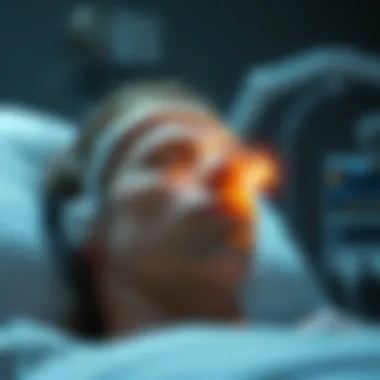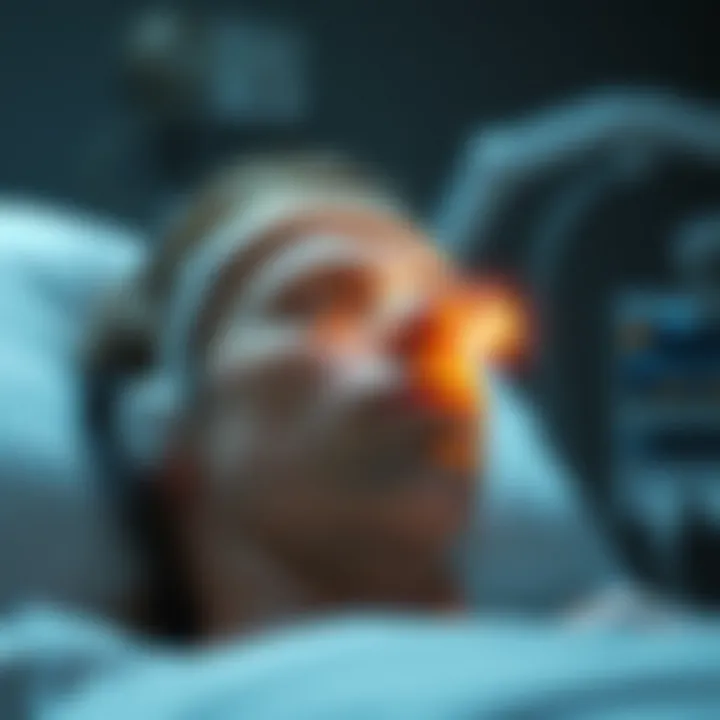Effective Strategies for Managing Central Sleep Apnea


Intro
Central sleep apnea (CSA) can often be overshadowed by its more commonly discussed counterpart, obstructive sleep apnea. Despite being less prevalent, its impact on physical health and daily functioning shouldn’t be shrugged off. Understanding the nature of CSA is the first step in crafting effective management strategies. This article delves into various aspects of CSA, particularly focusing on diagnosis, treatment options, lifestyle adjustments, and technological advancements that have emerged in recent years.
The importance of tackling central sleep apnea cannot be overstated. Many individuals suffering from CSA report significant disruptions to their sleep patterns, leading to daytime fatigue and a decline in overall well-being. Consider this: when one’s breath is interrupted, it’s not just the physical act of breathing that halts, but also the mental clarity and emotional stability that can waver. This article seeks to offer insights not just to those directly affected, but also to their families and caregivers, facilitating a better understanding of this multifaceted condition.
Strategies for managing CSA can vary widely. They can include medical interventions, lifestyle modifications, and even behavioral therapies as part of a holistic approach to care. As we venture into this exploration of approaches to manage CSA, we aim to shed light on comprehensive strategies, enabling individuals to reclaim their night's rest and improve their quality of life.
Understanding Central Sleep Apnea
What is Central Sleep Apnea?
Central sleep apnea occurs when your brain essentially forgets to signal your body to breathe during sleep. That’s not exactly a hallmark of a restful night, is it? Unlike obstructive sleep apnea, where the issue is a physical blockage in the throat, CSA is rooted in neurological factors. This condition leads to the cessation of breathing for certain periods, sometimes lasting several seconds or even minutes. Immediate awareness of this condition is crucial, not just for diagnosis but also for preventative measures.
The Importance of Recognizing Symptoms
If you or someone you love is experiencing disrupted sleep, an essential piece of the puzzle is recognizing the symptoms of CSA. These can manifest in various ways:
- Frequent awakenings during the night
- Extreme daytime drowsiness
- Difficulty concentrating
- Mood swings or irritability
Taking note of these indicators can be the key to getting timely help. When symptoms become prominent, differentiating between CSA and other forms of sleep apnea is vital to ensure proper treatment starts from the get-go.
Treatment Options
Managing CSA often involves a multi-faceted approach:
- Continuous Positive Airway Pressure (CPAP): This is a widely recognized treatment method. It uses a machine to deliver air pressure through a mask to keep the airways open during sleep.
- Adaptive Servo-Ventilation (ASV): Intended for CSA, this device responds to your breathing patterns and adjusts the pressure accordingly.
- Bilevel Positive Airway Pressure (BiPAP): Similar to CPAP but with different pressure settings for inhalation and exhalation.
- Medications: In some cases, medications may be prescribed to stimulate respiratory drive during sleep.
Each person’s journey with CSA is unique, making it essential that treatment plans are tailored to the individual.
Lifestyle Modifications
In conjunction with clinical treatments, certain lifestyle changes can significantly impact the management of CSA. Consider the following tips:
- Weight Management: For those who have additional weight, shedding even a few pounds can help.
- Avoiding alcohol and opioids: These substances can depress respiratory function and exacerbate CSA symptoms.
- Establishing a regular sleep routine: Going to bed at the same time each night may help improve sleep quality overall.
Emerging Technologies
The integration of technology into healthcare continues to evolve. Modern advancements have sought to better diagnose and manage CSA effectively. Devices like wearable sleep monitors can help track breathing patterns and sleep quality. This kind of precise data can be invaluable, enabling healthcare providers to adjust treatment plans efficiently.
The End
In summary, central sleep apnea is a challenging condition requiring nuanced approaches for effective management. With a blend of medical treatments, lifestyle changes, and new technologies, individuals can hope to reclaim control over their sleep and, consequently, their lives.
"The journey to restful sleep may be long, but every step taken is a step closer to finding the balance that works for you."
In understanding and managing CSA, it’s essential to remain proactive and informed, ensuring that you or your loved ones do not navigate this complex condition alone.
Understanding Central Sleep Apnea
Understanding central sleep apnea (CSA) is critical for both individuals experiencing symptoms and healthcare professionals aiming to help them navigate this complex disorder. CSA is not just a rare occurrence or a slight nuisance; it can profoundly impact an individual's health, lifestyle, and quality of life.
Defining Central Sleep Apnea
Central sleep apnea is characterized by pauses in breathing due to the brain's failure to send appropriate signals to the muscles that control breathing. Unlike obstructive sleep apnea, where the physical blockage of the airway is the primary problem, CSA originates from a neurological issue. Specific symptoms can include gasping or snorting during sleep, excessive daytime sleepiness, and marked fatigue. Recognizing these signs early can lead to timely intervention and treatment, which are vital in managing the condition effectively.
Differences from Obstructive Sleep Apnea
It’s important to grasp the contrast between CSA and obstructive sleep apnea (OSA). While CSA lacks the physical obstruction present in OSA, it can share similar symptoms, leading to confusion if not accurately diagnosed. In OSA, weight and physical airway structure often play important roles, whereas CSA is more associated with medical conditions that affect the central nervous system, such as heart failure or stroke. Being aware of these differences can significantly influence treatment options and therapeutic approaches.
Prevalence and Risk Factors
The prevalence of CSA is often underestimated. It can affect people of any age, but it is more frequently observed in adults and those with certain risk factors like cardiovascular issues, older age, and even altitude. Some research indicates that around 1% of the general population may suffer from CSA. Knowing the risk factors can help in identifying at-risk individuals sooner, thereby enhancing health outcomes through early diagnosis and management strategies.
"Early recognition and treatment of central sleep apnea can significantly improve the quality of life for affected individuals."
In summary, gaining a solid foundation of understanding central sleep apnea is crucial for making informed decisions about treatment, lifestyle adaptations, and monitoring this intricate condition. Addressing CSA comprehensively ensures no stone is left unturned in pursuing better health and well-being.
Diagnosis of CSA
Diagnosing Central Sleep Apnea (CSA) is critical for effective management of this condition. Understanding how to accurately identify CSA not only paves the way for appropriate treatment but also significantly enhances a patient’s quality of life. Often, people experience various symptoms that can go unnoticed, making early diagnosis paramount. The consequences of undiagnosed CSA can lead to serious health implications, impacting physical and mental well-being.
Identifying Symptoms
Recognizing the symptoms of CSA can be tricky, as they sometimes overlap with other disorders. Commonly reported signs include:
- Gasping for air during sleep, which may wake you up abruptly.
- Choking sensations that can induce feelings of panic.
- Daytime sleepiness, making it difficult to concentrate or function at work.
- Insomnia, often leading to frustration when trying to get a good night’s rest.
- Mood swings or increased irritability, which might not seem directly related to sleep issues.


These indicators often fly under the radar. Many people might dismiss these signs as temporary fatigue or stress from their daily lives. However, if someone notices these patterns persistently, it’s worth seeking professional evaluation.
Diagnosing CSA isn’t just about recognizing symptoms. It’s also about knowing how to communicate these experiences effectively to healthcare providers. Clear descriptions can help in the overall assessment and lead to a more targeted diagnosis.
Diagnostic Procedures
Once symptoms have been identified, the next step is the diagnostic procedures. A couple of methods are primarily used to assess CSA:
- Polysomnography (PSG): This is considered the gold standard for diagnosing sleep disorders. It involves an overnight stay in a sleep clinic where multiple bodily functions are monitored – from brain activity to oxygen levels, heart rate, and even eye movements.
- Home Sleep Apnea Testing (HSAT): For some patients, a home-based assessment may suffice. Minimal equipment is used to track breathing patterns and oxygen levels, usually over one or several nights.
- Clinical History: Healthcare providers typically take a thorough history, including sleep patterns, lifestyle factors, and any potential contributing health conditions.
- Physical Examination: A complete physical can help rule out other medical conditions contributing to sleep difficulties.
It is important to understand that no single method is foolproof. Sometimes a combination of tests provide the clearest picture of what’s occurring during sleep. Utilizing appropriate diagnostic procedures helps clinicians determine whether CSA is present and guide subsequent treatment strategies effectively.
Accurate diagnosis allows healthcare providers to customize interventions that can markedly improve a patient's quality of life.
In summary, being proactive in understanding CSA symptoms and the importance of clinical testing can go a long way in navigating this disruptive disorder. It sets the stage for informed discussions with healthcare professionals and encourages individuals to advocate for their health needs.
Medical Treatments for CSA
The management of Central Sleep Apnea (CSA) encompasses a variety of strategies, among which medical treatments play a pivotal role. These treatments are essential as they target the core issues underlying CSA, aiming to improve respiratory function during sleep. Moreover, they contribute to enhancing overall health and well-being, addressing not only the physical but also the psychological toll this condition can take on individuals. Each treatment stands out based on its mechanisms, usage, and outcomes, warranting a closer look.
Positive Airway Pressure Therapy
Positive Airway Pressure therapy is often considered the cornerstone of CSA treatment. This method involves using a device that delivers air continuously to keep the airway open. A common type is the CPAP (Continuous Positive Airway Pressure) machine, which is frequently recommended and well-known. While it may initially feel odd to use a mask while sleeping, many users report significant improvements in their sleep quality and daytime alertness after a week or two.
There are advantages aplenty:
- Airflow Maintenance: It ensures that airflow is consistent, which lessens the likelihood of respiratory pauses.
- Adaptability: Devices can be adjusted according to an individual's specific needs, making them customizable.
However, it's worth noting that
- some users might find the mask uncomfortable, leading to a reluctance to use it consistently.
- Finding the right pressure setting can take time and may require consultations with healthcare professionals to ensure optimal outcomes.
Adaptive Servo-Ventilation
Adaptive servo-ventilation (ASV) offers another sophisticated approach to CSA management. This method is particularly useful for individuals who experience varying patterns of breathing irregularities. Unlike traditional positive airway pressure, ASV is designed to automatically adjust the pressure delivered based on real-time feedback on breathing patterns.
This treatment stands out due to several reasons:
- Dynamic Response: By continuously monitoring and adapting the pressure, ASV can optimize airflow while minimizing discomfort.
- Research Backing: Studies suggest that this approach can significantly reduce apneas and hypopneas, which directly correlates with better sleep quality.
Nevertheless, ASV may not be suitable for everyone, especially those with certain heart conditions. It's crucial to consult with a healthcare provider to gauge whether this adaptive method fits one's specific health status.
Medications
The realm of medications in CSA management is complex yet can greatly benefit some individuals. While medications are typically not the first line of defense, they can provide relief, particularly for those who do not tolerate the mechanical interventions well.
Commonly, doctors may prescribe
- Carbonic Anhydrase Inhibitors: These are designed to stimulate breathing during sleep, potentially reducing apnea events.
- Medroxyprogesterone Acetate: It's been employed to treat CSA by enhancing the respiratory centers' effectiveness.
While the idea of reaching for pills may seem appealing, the accompanying risks should be understood:
- Potential side effects such as dizziness or daytime sleepiness can occur, which is a significant consideration, especially where safety is a priority.
- Moreover, some medications may interact with existing treatments or illnesses, highlighting the importance of thorough discussions with healthcare professionals.
"Understanding your options is key; this condition is multifaceted and requires a tailored approach to achieve the best outcomes."
For a deeper dive into these treatments, consider consulting reputable resources such as Sleep Foundation or American Academy of Sleep Medicine.
Lifestyle Modifications
Lifestyle changes play a crucial role in the management of Central Sleep Apnea (CSA). Unlike just relying on medical treatments or devices, adjusting one’s daily habits can greatly improve overall well-being and reduce the frequency of CSA episodes. Understanding the significance of these modifications is vital for anyone looking to enhance their health.
Weight Management Strategies
Maintaining a healthy weight is one of the key lifestyle modifications that can alleviate the symptoms of CSA. Being overweight can exacerbate respiratory issues, so shedding those extra pounds can be quite beneficial. Here’s how to tackle weight management efficiently:
- Set realistic goals: Instead of jumping into extreme diets, aim for gradual changes. A loss of even 5-10% of body weight can lead to noticeable improvements in sleep quality.
- Incorporate physical activity: Engaging in regular exercise not only aids in weight reduction but also enhances overall respiratory function. Try activities like walking, swimming, or cycling that align with your interests.
- Mindful eating: Focus on nutrient-dense foods. Fruits, vegetables, lean proteins, and whole grains can help in maintaining a balanced diet. Steer clear of processed foods that may lead to weight gain.
Positional Therapy
Positional therapy revolves around the idea that sleeping positions can impact the severity of CSA symptoms. Many individuals find that sleeping on their back aggravates their condition. Here's what you can consider:
- Side sleeping: Sleep on your side to improve airflow and reduce airway obstruction. This change can promote better breathing patterns during sleep.
- Use specialized pillows: Certain pillows are designed to keep sleepers in the side position. You might want to explore options like wedge or contour pillows that can encourage proper posture during sleep.
- Practice habit-breaking techniques: If you have a tendency to roll onto your back at night, use positional alarms or devices to discourage this behavior.
Alcohol and Substance Use
The use of alcohol and certain substances can worsen Central Sleep Apnea. Understanding the consequences of these habits is crucial:
- Limit alcohol consumption: Alcohol can relax the throat muscles, leading to increased airway blockage during sleep. It’s wise to avoid alcohol, particularly before bedtime, to mitigate CSA risks.
- Be cautious with medications: Some sleep aids or medications may exacerbate breathing issues. Always discuss with a healthcare professional before starting or adjusting any medication regimen.
- Consider substance effects: Tobacco and certain recreational drugs can complicate your condition. Quitting smoking or reducing drug use can help improve sleep quality and overall health.


Adjusting your lifestyle isn’t just a quick fix; it’s about creating lasting habits that promote long-term wellness. By focusing on these modifications, individuals with Central Sleep Apnea can greatly improve their health and sleep quality.
Technological Advancements in CSA Management
Understanding the role of technology in managing Central Sleep Apnea (CSA) is crucial for both patients and healthcare providers. Technological advancements have transformed how CSA is diagnosed and treated, enabling more personalized and effective management strategies. The integration of sophisticated monitoring devices and telemedicine solutions exemplifies this evolution, making it easier for patients to track their conditions, communicate with healthcare professionals, and receive timely interventions.
Innovations in Monitoring Devices
In the past, diagnosing CSA relied heavily on sleep studies conducted in clinical settings. Now, innovations in monitoring devices have revolutionized this process. Wearable technology, such as smartwatches and sleep trackers, provides patients with real-time data on their breathing patterns, heart rate, and overall sleep quality. These gadgets can be helpful in managing CSA because they can alert patients to significant respiratory events that need to be addressed.
Furthermore, specialized devices like the ApneaLink or WatchPAT offer more detailed insights by measuring airflow and oxygen saturation. This information can assist doctors in making more informed treatment decisions. With continuous advancements, there's also potential for future devices to utilize AI algorithms for predicting sleep disturbances before they occur.
The increasing accessibility of these devices fosters a proactive approach where patients take charge of their health. However, challenges, such as the accuracy and reliability of consumer-grade devices compared to clinical equipment, should not be overlooked. Regular collaboration with healthcare providers is essential to ensure that data collected leads to appropriate interventions.
Telemedicine Solutions
Telemedicine has emerged as a game-changer in the management of CSA, particularly for those who have mobility issues or live in remote areas. Virtual consultations grant patients the ability to engage with healthcare professionals without the need for in-person visits. This is not only convenient but also facilitates consistent communication, allowing doctors to adjust treatment plans based on real-time feedback from patients.
Platforms like Teladoc Health and Amwell have made it easy for patients to discuss symptoms, review treatment effectiveness, and receive guidance on lifestyle changes that can improve their condition. Telemedicine also serves as a valuable resource during times of heightened concern, such as during a pandemic, when in-person visits may be restricted.
Moreover, the cost-effectiveness of telemedicine cannot be overstated. Patients save time and money by eliminating travel expenses while still receiving quality care. Yet, it is essential to remain aware of data privacy issues and ensure that platforms used are secure and compliant with regulations.
"Advancements in technology enable better self-management and tailored healthcare plans for patients with Central Sleep Apnea."
Cognitive Behavioral Strategies
In managing Central Sleep Apnea (CSA), addressing the psychological aspects alongside the physiological ones can significantly enhance outcomes. Cognitive Behavioral Strategies (CBS) emerge as a vital component in this comprehensive approach, focusing on the interplay between thoughts, emotions, and behaviors that can affect sleep health. Within CBS, the goal is to reshape thought patterns surrounding sleep, thereby aiming to alleviate anxiety and develop healthier sleep-related behaviors. Not only does this encourage better rest, but it also empowers patients to take an active role in their own recovery journey.
Addressing Sleep Anxiety
Sleep anxiety can be a significant barrier for those suffering from CSA. The fear of not sleeping or experiencing episodes of apnea can create a vicious cycle, where anxiety leads to poor sleep, which in turn exacerbates anxiety. Addressing this anxiety is crucial. Techniques such as mindfulness meditation, deep-breathing exercises, and progressive muscle relaxation can benefit individuals by calming the mind and body.
- Mindfulness Meditation: Engaging in mindfulness can help individuals stay present, reducing the worry that often clouds their thoughts at bedtime.
- Deep-Breathing Exercises: Taking slow, deliberate breaths can signal the body to relax, making it easier to drift into sleep.
- Journaling: Writing down worries before bed can help in externalizing fears, often making them feel more manageable.
These methods serve not only to diminish anxiety but also reinforce a sense of control, essential in creating a more conducive sleep environment.
"Managing sleep anxiety is not just about putting the mind to rest; it's an act of claiming one’s own space in the night."
Establishing Sleep Hygiene
Establishing a robust sleep hygiene regimen is indispensable in mitigating the effects of CSA. Sleep hygiene pertains to the practices that can aid in fostering better sleep quality. Here are some key components:
- Regular Sleep Schedule: Going to bed and waking up at the same time daily helps regulate the body's internal clock.
- Sleep Environment: A quiet, dark, and comfortably cool room can do wonders for sleep quality. Consider blackout curtains, earplugs, or white noise machines.
- Limit Stimulants: Reducing caffeine and nicotine intake, especially in the hours leading up to bedtime, can prove beneficial.
- Nightly Rituals: Establishing a pre-sleep routine – like reading or soaking in a warm bath – can signal the body that it's time to wind down.
By incorporating these strategies, individuals can create a favorable atmosphere for sleep, diminishing instances of apnea and improving overall wellbeing. Engaging in CBT techniques alongside these practices fosters a holistic approach, enabling individuals to tackle CSA not only from a medical standpoint but also psychologically, thus enriching personal agency in managing their health.
For more further reading, check Wikipedia on Cognitive Behavioral Therapy and National Sleep Foundation Resources.
Monitoring Health and Progress
Monitoring health and progress is essential for individuals coping with Central Sleep Apnea (CSA). This form of apnea not only disrupts sleep but can have far-reaching implications for overall health. By tracking symptoms and managing treatment, one can gain insights into the effectiveness of interventions, making adjustments that will lead to better long-term outcomes. Here within, we detail two fundamental components essential for effective monitoring: regular follow-ups with healthcare providers and the implementation of self-monitoring techniques.
Regular Follow-ups with Healthcare Providers
Why are regular check-ins with healthcare professionals so crucial? For any individual grappling with CSA, these appointments serve multiple purposes. First and foremost, they provide a platform to evaluate the performance of any prescribed treatments, whether it’s a device like a CPAP machine or medications. The healthcare provider can assess symptom reduction, adjustments can be made as necessary, and new concerns can be addressed.
Regular follow-ups help track progress over time. A well-established routine can allow patients to see how far they’ve come and how treatment adjusts along the way. It’s easy to become disheartened if improvements aren’t visible. However, having a professional delve into the data from devices or symptom logs can provide valuable feedback.
There’s an often-overlooked psychological aspect too. Engaging with a healthcare provider fosters accountability. It’s a reminder that you’re not tackling this struggle alone. The care team is equipped with the latest knowledge and strategies. This can add a bit of reassurance during what can often feel like an isolating journey.
Self-Monitoring Techniques
On the flip side, self-monitoring is a potent tool for anyone managing CSA. This process entails tracking symptoms and treatment effectiveness in a way that works for the individual. This might involve keeping a sleep journal, recording when episodes occur, or noting any accompanying symptoms, such as daytime fatigue or mood changes.
Some useful self-monitoring strategies include:
- Sleep Diaries: Jotting down notes about sleep duration, quality, and any interruptions can help in recognizing patterns.
- Apps and Devices: There are plenty of modern gadgets available that can track sleep patterns and also provide analytic insights. Each can offer an overview of sleep cycles and disturbances.
- Milestone Checklists: Marking progress on a checklist for specific health goals can be motivating and provides visual evidence of advancements.
Self-monitoring empowers individuals. The more you know your body, the more effectively you can manage CSA.
By weaving together these self-tracking methods and regular interactions with healthcare providers, individuals can form a robust framework for monitoring their health and progress. Awareness is key. Knowing when to adapt treatment or reinforce positive habits can do wonders in the fight against CSA.
Support Systems and Community Resources
When it comes to managing Central Sleep Apnea (CSA), support systems and community resources play an invaluable role. This aspect often does not get the spotlight it deserves, yet it can make or break a person’s experience with the condition. Facing CSA can feel isolating; connecting with others who understand the journey can significantly ease the burden. Good community support can equip individuals with resources, information, and emotional relief, helping to create a more manageable path.
Beyond the physical and medical treatments discussed in other sections, the psychological and emotional facets of dealing with CSA are paramount. The value of having a supportive community cannot be understated. Individuals may find themselves sharing successes, failures, and experiences that can feel unique to the individual, but often resonate with the collective group. Whether through in-person meetings or online forums, these environments cultivate a sense of belonging.
Benefits of engaging in support systems include but are not limited to:


- Emotional Support: Being surrounded by others who genuinely empathize with your situation can bring a sense of relief and understanding.
- Sharing Coping Strategies: Individuals may exchange various approaches that have worked for them in managing CSA, thus broadening the available options.
- Access to Information: Support groups often provide access to knowledgeable individuals who can clarify doubts about CSA, its treatments, and lifestyle adaptations.
- Accountability: Regular meetings or discussions might ensure that members stay committed to managing their condition effectively.
"Finding a supportive environment transformed my way of living with CSA. I realized I wasn't alone, and that made all the difference." - Patient Testimonial
Joining Support Groups
Getting involved in support groups can be a turning point for those facing CSA. These gatherings can manifest in various forms such as local meetings, online communities, or even social media groups dedicated to sharing knowledge and experiences about sleep disorders. Opportunities abound for providing and receiving help, making these platforms versatile and accessible.
A few noteworthy aspects about support groups include:
- Diverse Perspectives: Members share their unique journeys, providing a wealth of knowledge and insight into what might work for others.
- Resource Sharing: Members often share literature, articles, and personal tips about coping mechanisms and resources that help manage CSA effectively.
- Built-in Motivation: Knowing others are on a similar journey fosters a collective spirit, providing motivation and encouragement.
Moreover, many groups often host guest speakers, including specialists in sleep medicine who can provide valuable information and answer queries that arise within the group.
Engaging with Professional Counselors
In parallel with peer-based support, seeking help from professional counselors who have experience in sleep-related issues can provide a more structured avenue for managing CSA. These professionals can help individuals address the underlying anxiety, stress, or depression that may accompany disruptive sleep patterns.
Professional counseling offers distinct advantages:
- Tailored Strategies: Counselors can work with individuals to devise personalized strategies that accommodate unique circumstances and experiences.
- Cognitive-Behavioral Techniques: Counseling often incorporates cognitive-behavioral techniques which help reshape negative thought patterns and promote better mental wellbeing.
- Support with Compliance: Counselors can also provide assistance in adhering to treatment plans, addressing any obstacles that may arise.
While support groups tackle communal aspects, engaging with a professional counselor helps to address the personalized, psychological components of living with CSA. This combination can foster well-rounded management, integrating both community support and professional guidance for a comprehensive approach to coping with Central Sleep Apnea.
For those interested in learning more about support resources, some reputable sites include American Sleep Association and National Sleep Foundation. These platforms provide additional insights and can link you to local support networks.
Understanding Long-Term Implications
Central sleep apnea (CSA) is not merely an episodic health concern; its long-term effects can linger, impacting various aspects of well-being. Understanding the implications of living with CSA is crucial for anyone navigating this complex disorder. Economically, healthcare costs associated with untreated CSA can skyrocket, affecting not just individual finances but also health systems, revealing the need for effective management strategies.
Greater awareness about the long-term effects offers several benefits:
- Improved Quality of Life: Awareness can lead to proactive approaches in treatment, enhancing daily functioning and overall happiness.
- Better Health Outcomes: Understanding potential risks can motivate individuals to pursue timely and comprehensive care, lowering chances of severe complications.
In this section, we’ll explore the specific health risks tied to CSA, alongside its impact on mental state and cognitive abilities, highlighting the importance of addressing these areas comprehensively.
Potential Health Risks Associated with CSA
The potential health risks connected with central sleep apnea are indeed worrisome. Beyond the immediate disruptions to sleep, individuals may face an array of health challenges:
- Cardiovascular Problems: CSA can contribute to hypertension, arrhythmias, and even heart failure. The repeated cessation of breathing causes fluctuations in oxygen levels, which can strain the heart over time.
- Neurological Issues: A lack of oxygen and sleep can adversely affect brain health, possibly leading to issues like stroke or transient ischemic attacks.
- Metabolic Dysregulation: CSA may influence glucose metabolism and lead to insulin resistance, heightening the risk of diabetes.
These health risks are not to be taken lightly. A proactive approach, including regular monitoring and healthcare follow-ups, is imperative.
Impact on Mental Health and Cognitive Function
Mental health and cognitive function often take a hit when dealing with CSA. The relationship between sleep and mental wellness is well-documented; poor sleep can lead to:
- Increased Anxiety and Depression: Sleepless nights can exacerbate feelings of anxiety, creativity, and vulnerability, leading to a cycle where poor mental health further diminishes sleep quality.
- Cognitive Impairments: Regular disruptions in sleep can result in memory issues, difficulty concentrating, and decreased problem-solving capabilities.
"Sleep is not a luxury; it's a necessity of life."
For individuals managing CSA, understanding these implications emphasizes the necessity for a holistic approach to treatment. Addressing both the physical and mental health aspects of this condition is essential for improving quality of life and long-term outcomes.
For additional resources, consider visiting the following:
Future Directions in CSA Research
Understanding the future directions in Central Sleep Apnea (CSA) research is crucial to improve how we manage this complex condition. As more people are diagnosed with CSA, research efforts aim to unravel the intricacies involved in its treatment and management. What’s on the horizon can provide hope for those grappling with the challenges posed by this disorder and fundamentally shift the landscape of care.
Emerging Therapies
Emerging therapies are at the forefront of CSA management. Traditional treatments, like positive airway pressure therapy, are effective; however, they don't work for everyone. Newer approaches look to fill that gap. One promising path is the exploration of neuromodulation techniques, which directly target the brain's control over breathing during sleep.
Additionally, researchers are studying innovative devices that adapt to an individual's unique breathing patterns, offering more personalized treatment options. This includes smart devices that analyze breathing disruptions in real-time and adjust settings dynamically, which can enhance treatment effectiveness and comfort.
Key areas to watch in emerging therapies include:
- Neuromodulation devices that stimulate parts of the brain responsible for respiratory function.
- Therapies based on genetic findings, which may lead to tailored treatments that consider individual genetic make-up.
- Combination therapies that might integrate different approaches for a holistic treatment plan.
In exploring such avenues, the goal is to not only improve sleep quality but also minimize the long-term health risks associated with untreated CSA.
Potential for Personalized Medicine
The potential for personalized medicine in the context of CSA is quite staggering. Unlike a one-size-fits-all approach, personalized medicine aims to tailor treatments based on individual characteristics, preferences, and specific needs. This might include genetic predispositions, lifestyle factors, or even biometric data collected through wearable technology.
For instance, as gathering data through wearable devices becomes more commonplace, researchers can analyze patterns in an individual’s sleep cycle, pinpoint potential triggers for CSA episodes, and refine treatment approaches accordingly. This personalization not only has the potential to improve adherence to prescribed therapies but also enhances the overall efficacy of treatments offered.
Some benefits of personalized medicine involve:
- Improved treatment adherence, as tailored approaches can resonate better with patients.
- Enhanced monitoring, as ongoing data collection can help anticipate problems before they become severe.
- Better outcomes, as treatments designed for the individual rather than the average population can lead to more meaningful improvements.
In summary, the future of CSA research holds great promise. By focusing on emerging therapies and the potential for personalized medicine, researchers and healthcare providers are carving pathways that may lead individuals closer to effective, tailored solutions for managing Central Sleep Apnea.















